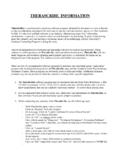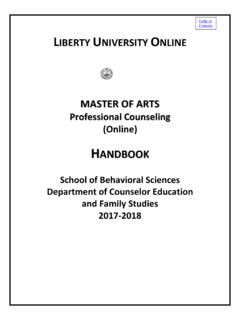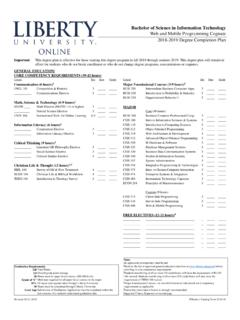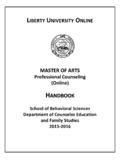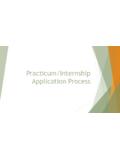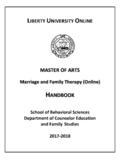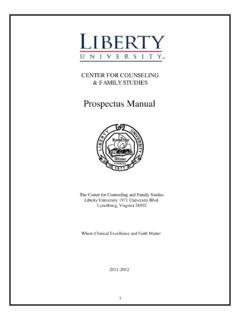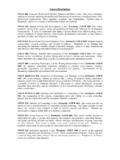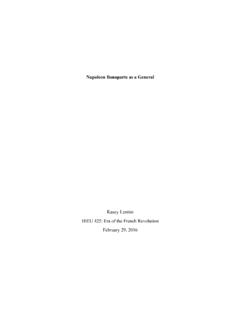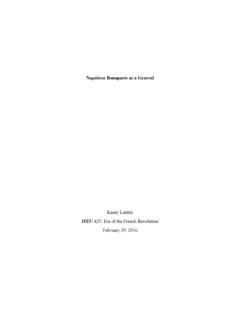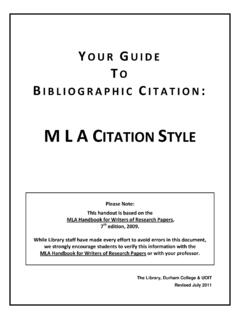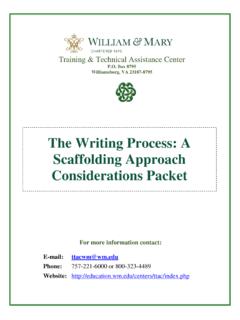Transcription of Running head: SAMPLE APA PAPER 1 A Sample Paper for the ...
1 Running head: SAMPLE APA PAPER 1 . A SAMPLE PAPER for the Purpose of Correct APA Formatting Student Name Liberty University SAMPLE APA PAPER 2 Table of Contents Abstract ..3 Basic Rules of Scholarly Writing ..4 Heading Levels Level 1 ..5 Level 2 Heading ..5 Level 3 heading ..5 Level 4 heading ..6 Level 5 Annotated Bibliographies, Tables of Contents, and Outlines ..6 Appendices ..7 Crediting Your Sources ..7 Three or More Authors .. 10 Primary Sources versus Secondary Sources .. 11 Personal Communications .. 11 Bible and other Classical Works .. 12 Lectures and PowerPoints .. 13 Dictionary Entries .. 14 Electronic 14 Final Formatting Tweaks .. 15 Exhaustive Reference List Examples & Additional Helpful Resources .. 16 Conclusion .. 17 References .. 18 Appendix: Annotated Bibliography .. 20 SAMPLE APA PAPER 3 Abstract Begin your abstract at the left margin (section on p.)
2 27 of your APA manual; see also p. 229). This is the only paragraph that should not be indented. Unless otherwise instructed, APA recommends an abstract be between 150 250 words (p. 27). It should generally not contain any citations or direct quotes. This should be a tight, concise summary of the main points in your PAPER , not a step-by-step of what you plan to accomplish in your PAPER . Avoid phrases such as this PAPER will, and just structure your sentences to say what you want to say. The following three sentences exemplify a good abstract style: There are many similarities and differences between the codes of ethics for the ACA and the AACC. Both include similar mandates in the areas of ----, ---, and ---. However, each differs significantly in the areas of ---, ---, and ---. For more detailed information, see Writing an Abstract at graduate/writing/?
3 PID=12268. This is just now at 171 words, so take a moment to eyeball how brief your abstract must be. Think of your PAPER as a movie, and the abstract as the summary of the plot that you would share to draw people s interest into wanting to come and see your movie. Same thing: you want to really hook and intrigue them. What you have to say is important! Still only at 237 words here; remember to try to stay under 250, unless your professor advises otherwise. The keywords noted below highlight the search terms someone would use to find your PAPER in a database; they should be formatted as shown (indented , with only the word Keywords in italics, and the few key words or phrases in normal print, separated by commas. Keywords: main words, primary, necessary, search terms SAMPLE APA PAPER 4 A SAMPLE PAPER for the Purpose of Correct APA Formatting The title of your PAPER goes on the top line of the first page of the body.)
4 It should be centered, unbolded, and in title case (all major words usually those with four+ letters should begin with a capital letter) --- see figure on p. 42 and on pp. 101-102 of your APA manual (American Psychological Association [APA], 2010). It must match the title that is on your title page. You can either give a brief introductory paragraph below that or go straight into a Level 1 heading. In APA format, the introduction never has a heading (simply begin with an introductory paragraph without the word "Introduction"); see first paragraph of section on page 27, as well as the first sentence under the bolded headings on page 63 of your APA manual. As shown in the previous sentence, use brackets to denote an abbreviation within parentheses (third bullet under ). Write out acronyms the first time mentioned, such as American Psychological Association for APA, and then use the acronym throughout the body of the PAPER ( ; note the section on underuse, however, at the top of p.)
5 107). Basic Rules of Scholarly Writing Most beginning students have difficulty learning how to write papers and also format papers correctly using the sixth edition of the APA manual (APA, 2010). However, the Liberty University Online Writing Center s (OWC) mission includes helping students learn how to be autonomous, proficient writers, and thus this SAMPLE PAPER is designed so it cannot be used as a template for inserting the correct parts. The OWC did, however, create video tutorials for specific elements; see the chart with links on the title page of this SAMPLE PAPER . For the purpose of instruction, this PAPER will use second person (you, your), but third person (this author) must be used in most student papers. First person (I, me, we, us, our) is not generally permitted in scholarly papers. Students should refrain from using first or second SAMPLE APA PAPER 5 person in academic courses (even though the APA manual encourages this in other writing venues) unless the assignment instructions clearly permit such (as in the case of personal reflection sections or life histories).
6 Though some written assignments will not require an abstract, understand that APA generally requires one unless otherwise stated in your assignment instructions or grading rubric. Heading Levels Level 1 This SAMPLE PAPER uses primarily one level of headings (Level 1), so most presented herein are centered and in boldface. APA style, however, has five heading levels, which will be demonstrated briefly for visual purposes. See page 62 of your APA manual (APA, 2010) if employing more than one level. Our Kaltura video on heading levels provides a good visual. Level 1 headings are bolded and in title case capitalize each major word (usually those with four or more letters), including hyphenated compound words. Four-Year Pilot Study on Attachment Disorders, and Self-Awareness of Pollen are examples of headings with compound words.
7 Do not capitalize articles (a, an, the) in headings unless they begin a title or follow a colon. Level 2 Heading Level 2 headings are bolded, in title case, and left-justified. The supporting information is posed in standard paragraph form beneath it. Never use only one of any level of heading. You must use two or more of any level you use, though not every PAPER will require more than one level. Level 3 heading. Level 3 headings are bolded, indented , in sentence case (only the first word should begin with a capital letter in most cases), and end with a period. Add two spaces, then begin typing your content on the same line, as presented in this paragraph. SAMPLE APA PAPER 6 Level 4 heading. Same as Level 3, except italicized, too. Level 5 heading. Same as Level 4, but unbolded.
8 Despite heavy writing experience, this author has never used Level 5 headings. Annotated Bibliographies, Tables of Contents, and Outlines APA does not regulate every type of PAPER and some elements in various assignments are not addressed in the APA manual, including outlines, tables of content, and annotated bibliographies. In those cases, follow your professor s instructions and the grading rubric for the content and format of the outline or annotations, and use standard APA formatting for all other elements (such as Running head, title page, body, reference list, 1" margins, double-spacing, Times New Romans 12-point font, etc.). Note that most academic papers will not require a table of contents, nor would one be appropriate. One was included in this PAPER simply for ease-of-access so students could go directly to the content they want to see.
9 Generally speaking, no table of contents would be necessary for papers less than 20 pages of content, unless otherwise required by your professor. That being said, when I organize outlines in APA format, I set my headings up in the proper levels (making sure there are at least two subheadings under each level), and then I use those to make the entries in the outline. Level 1 headings become uppercase Roman numerals (I, II, III), Level 2 headings become capital letters (A, B, C), Level 3 headings become numbers (1, 2, 3), Level 4 headings become lowercase letters (a, b, c), and Level 5 headings become lowercase Roman numerals (i, ii, iii). Some courses require working outlines, which are designed to have the bones and foundational framework of the PAPER in place (such as title page, abstract, body with title and headings, and references), without all the supporting meat that fills out and forms a completed PAPER .
10 SAMPLE APA PAPER 7 Appendices Appendices, if any, are attached after the reference list (see top of p. 230 of your APA manual). You must refer to them in the body of your PAPER so that your reader knows to look there (see top of p. 39). The word Appendix is singular; use it to refer to individual appendices. I attached a SAMPLE Annotated Bibliography as a visual aid (see Appendix). You will see that I included the title Appendix at the top of the page and formatted it in standard APA format beneath that. Because I only included one appendix, it is simply titled as such. If there are more appendices, assign a letter to each and denote each by that: Appendix A and Appendix B. Crediting Your Sources Paraphrasing is rephrasing another s idea in one s own words. Quoting is using another s exact words.
